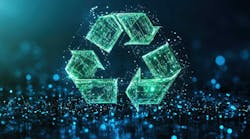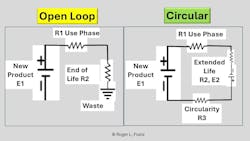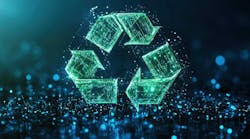What you’ll learn:
- What are the standards that can help guide you to optimizing the overall product lifecycle from initial manufacturing to end-of-life treatment?
- How to achieve longer product lifecycles to improve sustainability and reduce wasted resources.
- How product lifecycles can be made more closed loop.
A hot buzzword these days is “sustainability,” followed by the closely related “circular economy.” The European Union continues to push legislation on these fronts while the U.S. seems intent on ignoring or opposing those directions. But unlike the ages-old “circular” constant, pi, our true needs for guidance to achieve environmental sustainability in today’s world are undeniable and growing.
Fortunately, technical standards are available to help. Here we introduce several useful ways to enable designing longer-life products in the first place, then optimize material recovery to achieve closed-loop reuse of valuable materials when products inevitably reach the end of life.
Rather than show the typical circling arrow for product lifecycle, the figure shows a concept schematic diagram for our theme.
It’s not intended to be a working circuit. Rather, it’s more of an analogy that operates as follows:
- E1 represents the initial embodiment of energy and materials in the new product. By extension, E1 may also stand for all other lifecycle impacts besides energy, such as environmental impacts to water, land, and air quality.
- The Operation Phase shown by R1 is not literally a resistive load, but intended to be a generally lossy representation of the product in service.
- Following the use phase and before end of life, the next sequence represented by R2 and E2 stand for maintenance, spare parts, refurbishment, remanufacturing, etc., which extend the product life while contributing some initial material losses and need for incremental energy.
- Finally, the last leg through R3 represents a closed loop back to the next new product.
Contrast this with the open-loop figure. Starting with the same E1 going through product life losses through the same R1, the flow then goes directly to ground. In other words, no closed loop exists at all, and the product end-of-life waste may literally end up in the ground.
Eco-Design Standards
First, we introduce guidance on how to design more sustainable products. Second are some ways to use well-established methods to engineer reliability and durability, and plan for maintenance and repair to help extend product life. Third, when our goods inevitably become electronics scrap, standards can help set goals to achieve a closed-loop material cycle and help reduce the reliance on newly mined or manufactured materials.
Three standards offer excellent guidance for product eco-design and materials selection. (Note: IEC and EN documents must be purchased from the respective standards organizations so no direct links can be included here. But we provide enough publicly available information to hopefully whet your interest in them.)
IEC 62430: Environmentally conscious design for electrical and electronic products
IEC 62430 provides:
“…guidelines for minimizing the adverse environmental impact of devices throughout their lifecycle. The publication defines environmentally-conscious design for all electrical and electronic products, for instance which materials are used, the quantity of energy consumed to make them, as well as their rate of recyclability.”—IEC e-tech newsletter, May 2018
More about IEC 62430 was also covered in the author’s recent article in USNC Currents (“Grasping for Sustainability? Standards Come to the Rescue!”, Summer 2023, pp. 5-10), which is publicly available and shows key sections of the standard, including: Environmentally Conscious Design; Design Review; and Examples of Product-related Environmental Improvement Strategies.
EN45560: Method to achieve circular designs of products
This standard (EN = Europäische Norm) is filled with useful guidance on relevant topics like reuse which is the preferred method to extend product life. Also covered are other means of lifetime extension: durability, reliability, maintenance, repair, refurbishing, reconditioning, remanufacturing, and finally, recycling. Besides organizational targets, specific processes and examples are included.
Materials Selection
Here’s one of the key technical standards about how to reduce the environmental impact of materials:
IEC Technical Specification 63428: Guidance on material circulation considerations in environmentally conscious design
“IEC TS 63428:2024 describes principles and provides guidance on how to embed material circularity aspects into the design and development of products.
This includes making efficient use of materials and closing material flows in design and production, extending the lifetime of products through increased durability and enabling parts and materials to be reused or recycled at end-of-life.- Closing the material flows includes the use of recycled content and reused parts.
- Durability extensions include such measures as to improve reliability and maintenance, enable and facilitate repair, provide updates and upgrades, refurbish and reuse.
- Improvements in material recyclability, parts reuse, and remanufacturing are possible through measures such as design for disassembly, separability of materials, choice of materials, traceability of materials, and durability of parts.”—International Electrotechnical Commission
While much of this guidance applies to mechanical design and product-level packaging, some progress in “greener” components and circuit boards is also being made. For example, there’s a low halogen mold compound that minimizes toxins during end-of-life processing, and new circuit board laminates based on natural materials like lignin from trees.
Next, we move to guidance on product maintenance and repair parts, which are some of the other benefits of eco-product design to extend product life without complete replacement. This is because up-front provisions for spare parts or modules help keep the product in usable form with less environmental impact than requiring a complete replacement.
>>Download the PDF of this article, and check out the TechXchange for similar articles and videos
Extending Product Life
Two of the important concepts in this section are reliability and maintainability. After the first document listed, the rest are publicly available.
IEC 61709:2017 Electric components – Reliability: Reference conditions for failure rates and stress models for conversion
This 373-page standard gives additional details guidance on the use of failure rate data for reliability prediction of electric components used in equipment. Here’s a brief description:
“EC 61709:2017 gives guidance on the use of failure rate data for reliability prediction of electric components used in equipment. The method presented in this document uses the concept of reference conditions which are the typical values of stresses that are observed by components in the majority of applications. Reference conditions are useful since they provide a known standard basis from which failure rates can be modified to account for differences in environment from the environments taken as reference conditions. Each user can use the reference conditions defined in this document or use their own. When failure rates stated at reference conditions are used it allows realistic reliability predictions to be made in the early design phase.”—CSA Group
Guidelines to Understanding Reliability Prediction: European Power Supply Manufacturers Association
This publicly available 27-page document is a guide to reliability concepts like failure rate, mean time to failure (MTTF), mean time between failures (MTBF) and mean time to repair (MTTR). Reliability prediction is probably well known to those working in the military, aerospace, and related industries with critical high-reliability requirements. Automotive suppliers may be required to meet their own customer-specific standards (which is a topic for another article).
Note: While it’s not being suggested that all kinds of products need to be, or even should be, designed for High Reliability performance, many of the same principles and methods are widely applicable even though published as MIL Standards. Nor does this introduction attempt to duplicate any of the many excellent textbooks or courses on reliability engineering or the requirements to become a Certified Reliability Engineer, etc. But the lessons taught by these documents are free to those who want to use them in a lean approach suitable for your company’s products.
Updated software tools to complement the written standard methods may also be found, for example at https://relyence.com and https://www.hbkworld.com/en/solutions/applications/reliability.
MIL-HDBK-217F: Reliability Prediction of Electronic Equipment
One of the main results of this prediction by component type is that parts most likely to fail should be understood and mitigated as early as possible. Since failure rates multiply together, product complexity can only increase the likelihood of failure. Concepts like MTTF and MTBF lead to statistical distributions, calculations, and predictions.
They’re mentioned here only for the sake of awareness, the point being that longer-lived products prevent the proliferation of new products to replace them. This increases the initial product environmental footprint and creates additional challenges for circularity.
MIL-STD-202G: Test Method Standard Electronic and Electrical Component Parts
Products will not always have the luxury of sitting on a shelf in unchanging surroundings. For example, temperature variations, even just transporting the product to the market, are real. The same is true for relative humidity.
A design team can tailor a test plan for accelerated life testing that corresponds to the expected end-use environment of a given product. These test conditions may include stresses like high and low temperature, thermal shock, humidity, and moisture, or if appropriate, environments like sand, dust, or salt spray. On the mechanical side, vibration and mechanical shock, as well simulated shipping of the product, may be appropriate.
Manufacturers of outdoor products like automobiles and trucks know these conditions well. Even consumer products may benefit in the marketplace from the assurance of reliability in the field through this type of testing.
MIL-STD-1629A: Procedures for Performing a Failure Mode, Effects and Criticality Analysis
In this method, consideration is given to how any aspect of a product could fail to perform. Each potential failure is ranked by its likelihood of occurrence and the severity of its effect on product function so that appropriate corrective actions may be taken to eliminate or control the high-risk items. The method can be applied to both design and production.
Three standards provide useful technical guidance for predicting, testing, and improving the expected life of products before they’re even placed on the market, including those not intended to be High Reliability.
MIL-HBK-472: Maintainability Prediction
“A significant advantage of using a maintainability prediction procedure is that it highlights for the designer, those areas of poor maintainability which justify product improvement, modification, or a change of design.”—U.S. Dept. of Defense
Simply put, items like chemical or mechanical parts that may wear out before solid-state electronics, like batteries and rotating components, would wisely be accommodated by designs that accommodate repair or maintenance parts. While this is common sense, it supports product longevity, which is a key principle of sustainability.
Finally… Recycling Technology
Ultimately, every product must reach the end of its useful life. Then material recovery and recycling become critical to enable material circularity and reuse in new products, as opposed to ending up as waste.
Within the IEC 62430 framework, again, are examples of recyclability for “… electronics products where copper and precious metals can be recovered and remade into new products to reduce the impact of mining new metals.”— USNC Currents
This final material recycling and recovery step is critical to closing the circular economy of all materials, not just metals. Other standards come in to help here as well. Ultimately, both the original product and any spare parts installed to prolong useful life will need to enter the recycling phase to complete the circle.
First, we list a series of standards with separate parts dedicated to specific types of equipment:
BS EN 50625: Collection, logistics & treatment requirements for WEEE
WEEE is the acronym for Waste Electrical and Electronic Equipment. This multi-part document contains the following parts, including specific types of equipment:
- Part 1: Collection, logistics & Treatment requirements for WEEE. General treatment requirements
- Part 2-1: Collection, logistics & treatment requirements for WEEE. Treatment requirements for lamps
- Part 2-2: Collection, logistics & treatment requirements for WEEE. Treatment requirements for WEEE containing CRTs and flat panel displays
- Part 2-3: Collection, logistics & treatment requirements for WEEE. Treatment requirements for temperature exchange equipment and other WEEE containing VFC and/or VHC
- Part 2-4: Collection, logistics & treatment requirements for WEEE. Treatment requirements for photovoltaic panels
Attention is called to Part 5 of EN 50625, which directly addresses commonly recyclable metals in electronics, copper, gold, silver, and palladium:
EN 50625-Part 5, now DS/CLC/TS 50625-5:2017: Specification for the final treatment of WEEE fractions - Copper and precious metals
This Technical Specification addresses the processes regarding the recycling of copper and/or precious metals contained in WEEE and fractions of WEEE. In addition to copper, the precious metals in scope of the standard are gold, silver and palladium. A table on Metal Yield specifies for the four metals—copper, gold, silver and palladium—an input to recycling of 100% and a minimum recovery yield of 90% by weight. (Quoted from the GlobalSpec site)
A metal smelter is the place where many metals are recycled to be reused over and over, so this is a very critical step in a circular economy. These operations may combine the processing of raw ore with end-of-life goods, sometimes called urban mining due to relatively valuable amounts of precious and related metals in electrotechnical products.
Standards also exist for different recovery streams from electronics.
ReMA (Recycled Materials Association) Specifications Circular
The ReMA Specifications Circular provides guidelines for buying and selling a variety of processed scrap commodities, including ferrous and nonferrous metals, paper, plastics, electronics, rubber, and glass. Of interest are such materials as Circuitboards and Shredded Circuitboards From the Processing of End-of-Life Electronics and Shredded Insulated Copper Wire. Another large group of materials is covered by Automobile Shredder Residue.
A circular product designer should be aware of such possible end-of-life specifications and try to meet or exceed the requirements, not the least of which are limits on various types of contamination due to unwanted materials.
Due to the nature of electrotechnical products, conductors like metals and insulators such as polymers are ubiquitous. Improving the common technologies and standards that can be applied to material recovery and recycling is a challenge to continuously improve material circularity.
Components that require stable configurations of metals, plastics, and other materials like ceramics are currently processed by shredding and sorting operations. Then, ultimately, the metals are sent to a smelter for recovery along with newly mined ore.
Consideration to at least be able to release a circuit board and components from a mechanical housing, and keep larger mechanical housings limited to as few different materials as possible, is probably still the most common-sense guidance that can be given today.
Conclusions
The table shows a list of documents and their applicability to either design and materials selection; reliability and maintainability; or end-of-life recovery and recycling.
This brief survey touches on some of the highlights of existing standards that are available to support and improve the circularity of materials. These will need to be joined with the broader business, economic, social, and political environments around the world to drive continued progress. In simple terms, we need to make the circle of product life bigger to use fewer resources.
Considerable progress has already been made. Let it become standard practice and continue!




